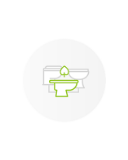Urine Diversion Application
Urine diversion - it divides the composting toilet community. Some advocate for, others advocate against... So, is it actually beneficial and what is its application?
Contrary to popular belief, urine isn't actually harmful to compost. Not only does it enrich compost with nitrogen, but it also hydrates it. Additionally, when the urine is absorbed into the compost pile and processed via compost maturation, it becomes a controlled substance that can go into the environment without a runoff - this is better for the environment and for soil regeneration. Too much urine, however, can be problematic. It can saturate the pile and overload it with ammonia. It can also hinder compost in cold climates, decreasing its ability to retain heat. Therefore, urine diversion is beneficial in some scenarios.
There are two types of urine diverting composting toilets - urine diversion to soak-away, suitable for residential application, and urine diversion to a container, suitable for mobile composting toilets and emergency/backup toilets.
Below, are the applications of both types of systems.
Note that although compost does need hydration to stay healthy, weekly cleaning of the toilet should be sufficient in introducing enough water to the compost pile of a urine diverting compost toilet. However, in hot climates (above 20°C average temperature), the compost pile of urine diverting toilets will dry out and will need re-hydration.
Urine Diversion to Soak Away (UD-S)
Composting toilets with urine diversion to soak away are mainly applicable to two scenarios - fluctuating high urination and cold climate. Such systems see solids composted in their own composting chamber, while urine is diverted to a sub-strata soak-away.
See product as an example:
Fluctuating High Urination Scenario (regular parties/group gatherings)
If you're prone to throwing parties/hosting large amounts of visitors regularly, urine diversion may be a good idea. Group gatherings tend to see a lot of drinking and, as a result, a lot of peeing. When such a large amount of peeing is taking place regularly, urine can saturate the compost and become a problem. It can overload the system with ammonia, offsetting the composting balance and causing foul odour. Urine diversion is a great way to prevent this from happening - it will keep the compost healthy and prevent smells.
Note that fluctuating high urination is different to intermittent high urination. Fluctuating high urination applies to regular scenarios of high urination only. Intermittent high urination applies to the odd occasion of group gatherings and can be managed by an all-in-one composting toilet with temporary addition of highly absorbent bulking agent and compost black (ammonia absorbing agent).
Cold Climate Scenario (below 13°C average temperature)
Urine Diversion is beneficial in colder climates in which the composting toilet is installed outside/inside a non-acclimatized building (below 13°C average temperature). Reducing the moisture content of organics makes them less susceptible to thermal sink (heat loss/heat gain) - a dryer compost is a more insulated compost, capable of better heat retention. If your toilet is inside an acclimatized building, urine diversion is not essential. If, however, the toilet is in a cold environment and the chambers are in a location without solar gain or other forms of passive heating, urine diversion is beneficial and will help to avoid the loss of bio-activity caused by low temperature. Note that composting will take place down to 3°C, but its efficiency is greatly reduced below 13°C. Read How to Maximize Passive Heating to learn about keeping your compost warm and operational in cold climates.
Urine Diversion to Container (UD-C)
Urine diversion to container systems are great for mobile toileting in RVs and as back-up or emergency toilets. Such systems see urine collected in its own separate container, rather than having it plumbed into a sub-strata soak away. This means that you will need to dispose of urine manually, which requires having an appropriate way to do so available to you. Urine can be poured down existing public/private toilets or disposed of at dump stations. For more info, see How to Dispose of Urine from a Urine Diversion to Container System.
See product as example:
Mobile Toilet Scenario
Love hitting the road but unsure on which toilet to install in your RV? Composting toilets that divert urine to container are the perfect solution to mobile toileting. Such systems separate solids and liquids into separate chambers, providing a decent berthing cycle and convenience in terms of waste disposal. Having the urine in a separate container means it can be easily disposed of into public toilets/dump stations you encounter on the road. It also means the solids chamber fills up slower, giving you more time on the road before it needs to be emptied.
Emergency/Back-up Toilet Scenario
If you live in an emergency prone area and would like to ensure your family is able to toilet shall disaster strike, or if you're simply looking for an additional toilet to accommodate more people, then urine diversion to container is a great option. Provided, however, that you have the appropriate means of urine disposal available to you. Generally, this means the existence of another toilet on-site, connected to sewerage or septic tank. For more info see How to Dispose of Urine from a Urine Diversion to Container System.
Need help choosing a system? Call WCTNZ® on 0800 022 027 for free advice on system specification and setup. Advanced design consultancy services are also available.
WCTNZ® | Waterless Composting Toilets NZ Limited | Copyright 2023 ©















